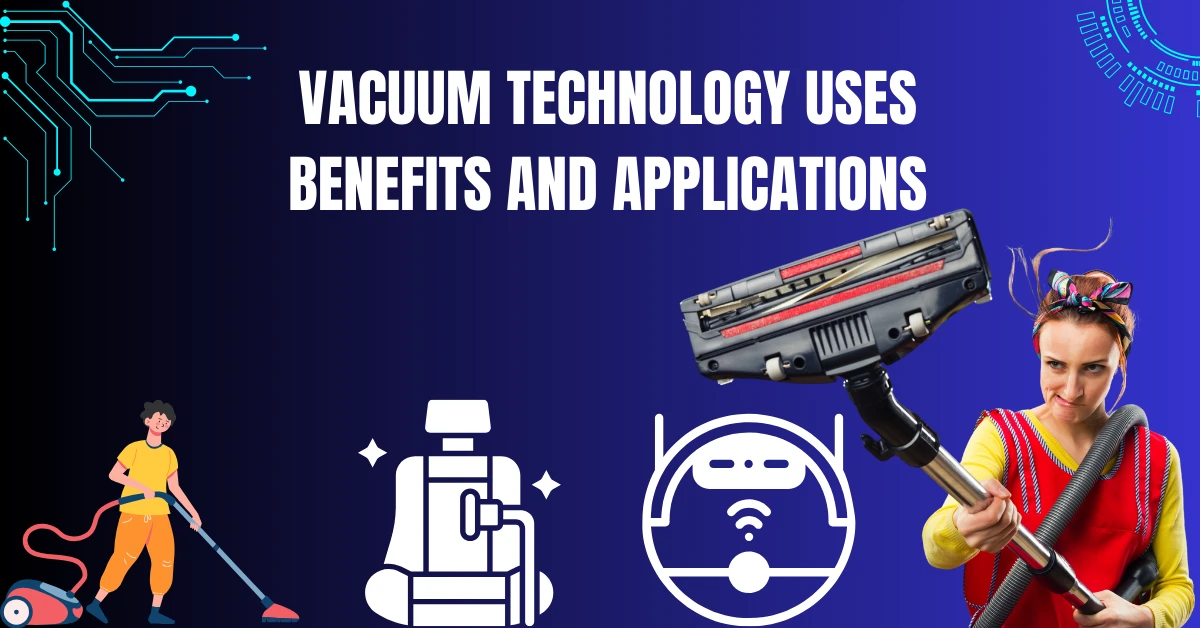The manipulation and control of surroundings with little to no pressure is the main emphasis of the scientific and engineering field of vacuum technology. It entails the production and upkeep of a vacuum. Which is an empty space free of matter, especially gas molecules. The origins of this technology can be traced back to the 17th century. When researchers and innovators started investigating the characteristics and uses of lower pressure settings. Due to its many uses and advantages. Vacuum technology is now essential to many scientific fields as well as a wide range of industries.
Medical technology encompasses a wide range of innovative tools and equipment designed to improve healthcare outcomes. For beginners, it’s a fascinating field where science meets medicine. From diagnostic devices like MRI machines and CT scanners to surgical robots and telemedicine solutions. These advancements aid in accurate diagnoses, efficient treatments, and patient care. Medical technology plays a vital role in enhancing patient well-being. Improving medical procedures, and advancing the healthcare industry as a whole, making it an exciting and dynamic field for those looking to explore its potential.
How Vacuum Technology Works
It is crucial to comprehend the idea of a vacuum in order to comprehend vacuum technology. When gas molecules are eliminated from a particular area, a vacuum is produced, which lowers the pressure there compared to the surrounding environment. There are several ways to accomplish this removal of gas molecules:
1. Pumping:
The most popular technique is to remove gas molecules from a container using vacuum pumps. There are several varieties of these pumps, such as cryogenic, turbomolecular, and rotary vane pumps. Gas flows from the vacuum chamber to the pump as a result of the pressure gradient they create.
2. Evacuation:
When a chamber is evacuated, air or other gases are continually removed in order to gradually reduce the pressure inside the chamber until the intended vacuum level is reached. This technique is frequently applied in vacuum packaging and related fields.
3. Chemical Absorption:
Certain substances, like activated charcoal or zeolites, can draw in gases and produce a vacuum. These materials are frequently employed in smaller-scale applications, such as vacuum-sealed containers or gas masks.
4. Physical Means:
Gas molecules can condense or settle at a lower pressure when their kinetic energy is reduced by methods like cryogenics (cooling) or laser cooling.
By sealing the vacuum chamber to keep gas molecules from reentering, a vacuum can be maintained once it has been established.
The Uses of Vacuum Technology

Because of its special qualities, vacuum technology is used in many different fields of science and industry. These are a few of its main applications:
1. Manufacturing and Processing
Semiconductor Fabrication:
Vacuum technology plays a major role in the semiconductor industry in operations including ion implantation, etching, and chemical vapor deposition. A clean, gas-free environment is necessary to manufacture microchips of superior quality.
Coating and Surface Treatment:
Thin films of materials are applied to surfaces using vacuum coating processes, such as physical vapor deposition (PVD) and chemical vapor deposition (CVD), to improve hardness, corrosion resistance, or optical qualities.
Heat Treatment:
Annealing, brazing, and sintering are heat treatment procedures that are carried out in vacuum furnaces. Vacuum operation keeps materials from oxidizing and becoming contaminated.
2. Scientific Research
Particle Physics:
Ultra-high vacuums are produced in high-energy particle accelerators to lower air resistance and allow particles to travel at high speeds. For particle physics experiments, this is crucial.
Materials Science:
Phase transitions and the behavior of materials at low pressures are among the features of materials that researchers can examine in controlled situations using vacuum chambers.
Space Simulation:
For the purpose of testing materials and equipment that will be utilized in space missions, vacuum chambers are used to replicate space conditions.
Medical and Healthcare

Analytical Instruments:
To reduce air interference and increase precision, mass spectrometers, electron microscopes, and other analytical instruments work in vacuums.
MRI Machines:
Superconducting magnets, which are used in some MRI scanners, must operate in extremely low pressure conditions.
4. Packaging and Food Preservation
Vacuum Packaging:
By eliminating air, vacuum packaging in the food sector slows down the oxidation and multiplication of spoilage bacteria, extending the shelf life of products.
Electronic Components:
To stop oxidation and degradation, sensitive electronic components are frequently encased in an inert gas or vacuum.
5. Energy and Environment
Solar Panels:
Solar panels are made using vacuum technology, which encloses photovoltaic cells to shield them from the elements.
Nuclear Fusion:
Vacuums are necessary in experimental fusion reactors in order to confine and regulate the highly hot and reactive plasma.
Benefits of Vacuum Technology
Vacuum technology offers several significant benefits:
Contamination Control:
Vacuum technology creates a clean and regulated environment by eliminating gases and contaminants, which is essential for applications like materials research and semiconductor fabrication.
Temperature Control:
Since vacuums are such good insulators, vacuum chambers may be precisely controlled in temperature. For procedures like heat treatment and crystal formation, this is necessary.
Reduced Friction:
Reduced friction and energy waste in low-pressure conditions enable faster speeds and efficiency in applications such as particle accelerators and space exploration.
Extended Shelf Life:
By preventing oxidation and microbiological growth, vacuum sealing prolongs the shelf life of perishable goods in food packaging.
Improved Precision:
The absence of air improves precision and lessens interference for analytical instruments and scientific research.
Environmental Applications:
Mass spectrometry, which is used to analyze air quality, is one application of vacuum technology in pollution management and environmental monitoring.
Applications of Vacuum Technology
1. Electronics and Semiconductor Industry
A key component of the electronics and semiconductor manufacturing sector is vacuum technology. It is employed in procedures like:
Deposition:
Integrated circuits are made by depositing thin layers of various materials onto silicon wafers.
Etching:
To define circuit patterns, unwanted materials are removed from the wafer’s surface.
Ion Implantation:
The wafer is implanted with ions to change its electrical characteristics.
Wafer Cleaning:
Prior to processing, wafers are cleaned in vacuum chambers to get rid of impurities.
2. Materials Science and Metallurgy
Researchers in materials science and metallurgy use vacuum technology for:
Phase Diagram Studies:
examining the behavior of materials at various pressures and temperatures.
Vacuum Induction Melting:
manufacturing metals and alloys of high purity.
Powder Metallurgy:
compacting and sintering metal particles in a vacuum to create products with desired qualities.
3. Aerospace and Space Exploration
Space Simulation:
Spacecraft parts are tested in vacuum chambers to make sure they can endure the intense heat and vacuum of space.
Thruster Testing:
Rocket engines are tested under circumstances similar to those seen in vacuum chambers.
4. Medical and Healthcare
Electron Microscopy:
Vacuum conditions are necessary for high-resolution electron microscopes to function properly.
Proton Therapy:
Proton therapy machines focus and accelerate proton beams for use in cancer treatment. They work in a vacuum.
5. Food Packaging
Vacuum Packaging:
used to remove air from packing so that perishable items stay fresh longer.
Deuteration:
removing air to increase the shelf life of food items like soups and sauces.
6. Energy Production
Solar Panels:
Solar cells are shielded from the elements by vacuum encapsulation, which guarantees their long-term performance.
Nuclear Fusion:
The high-temperature plasma in experimental fusion reactors is contained and managed using vacuum chambers.
Conclusion
The capacity of vacuum technology to produce and preserve low pressure settings has made it an essential tool in many scientific and industrial fields. It is used in everything from space exploration and medical research to manufacturing and materials science. It is a crucial part of many technological breakthroughs because of its advantages, which include greater precision, temperature regulation, and contaminant control.
Vacuum technology is expected to become even more important in a wide range of applications as it develops. Vacuum technology will continue to have a huge impact on our planet in many ways, whether it is through the creation of more compact and effective vacuum pumps or the exploration of uncharted territory in space.
FAQs
1. What is a vacuum?
A vacuum is an empty space, especially for gas molecules. It is produced by taking away the gas molecules in a certain area, which lowers the pressure there compared to the ambient environment.
2. When did vacuum technology start?
Vacuum technology was first explored in the 17th century, when innovators and scientists such as Robert Boyle and Evangelista Torricelli carried out ground-breaking research.
3. What are the primary uses of vacuum technology?
Applications of vacuum technology include food preservation and packaging (such as vacuum packaging), scientific research (such as particle physics experiments), medical and healthcare (such as electron microscopy), manufacturing and processing (such as semiconductor fabrication), and energy and environmental applications (such as solar panel manufacturing).
4. What are the benefits of vacuum technology?
Vacuum technology has several advantages, such as controlling contamination, regulating temperature, lowering friction, extending product shelf life, increasing scientific experiment precision, and having a variety of environmental applications.
5. How does vacuum technology work?
The way vacuum technology operates is by pumping, evacuating, chemically absorbing, or physically eliminating gas molecules from a space. By sealing the vacuum chamber to keep gas molecules from reentering, a vacuum can be maintained once it has been established.







